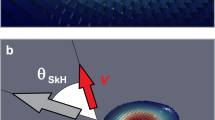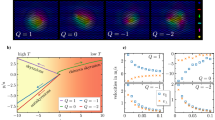Abstract
The well-known Hall effect describes the transverse deflection of charged particles (electrons/holes) as a result of the Lorentz force. Similarly, it is intriguing to examine if quasi-particles without an electric charge, but with a topological charge, show related transverse motion. Magnetic skyrmions with a well-defined spin texture with a unit topological charge serve as good candidates to test this hypothesis. In spite of the recent progress made on investigating magnetic skyrmions, direct observation of the skyrmion Hall effect has remained elusive. Here, by using a current-induced spin Hall spin torque, we experimentally demonstrate the skyrmion Hall effect, and the resultant skyrmion accumulation, by driving skyrmions from the creep-motion regime (where their dynamics are influenced by pinning defects) into the steady-flow-motion regime. The experimental observation of transverse transport of skyrmions due to topological charge may potentially create many exciting opportunities, such as topological selection.
This is a preview of subscription content, access via your institution
Access options
Subscribe to this journal
Receive 12 print issues and online access
$209.00 per year
only $17.42 per issue
Buy this article
- Purchase on Springer Link
- Instant access to full article PDF
Prices may be subject to local taxes which are calculated during checkout





Similar content being viewed by others
References
Mühlbauer, S. et al. Skyrmion lattice in a chiral magnet. Science 323, 915–919 (2009).
Yu, X. Z. et al. Real-space observation of a two-dimensional skyrmion crystal. Nature 465, 901–904 (2010).
Zang, J. D., Mostovoy, M., Han, J. H. & Nagaosa, N. Dynamics of skyrmion crystals in metallic thin films. Phys. Rev. Lett. 107, 136804 (2011).
Braun, H. B. Topological effects in nanomagnetism: from superparamagnetism to chiral quantum solitons. Adv. Phys. 61, 1–116 (2012).
Lin, S. Z., Reichhardt, C., Batista, C. D. & Saxena, A. Driven skyrmions and dynamical transitions in chiral magnets. Phys. Rev. Lett. 110, 207202 (2013).
Nagaosa, N. & Tokura, Y. Topological properties and dynamics of magnetic skyrmions. Nat. Nanotech. 8, 899–911 (2013).
Everschor-Sitte, K. & Sitte, M. Real-space Berry phases: skyrmion soccer (invited). J. Appl. Phys. 115, 172602 (2014).
Zhou, Y. & Ezawa, M. A reversible conversion between a skyrmion and a domain-wall pair in a junction geometry. Nat. Commun. 5, 4652 (2014).
Büttner, F. et al. Dynamics and inertia of skyrmionic spin structures. Nat. Phys. 11, 225–228 (2015).
Schulz, T. et al. Emergent electrodynamics of skyrmions in a chiral magnet. Nat. Phys. 8, 301–304 (2012).
Milde, P. et al. Unwinding of a skyrmion lattice by magnetic monopoles. Science 340, 1076–1080 (2013).
Heinze, S. et al. Spontaneous atomic-scale magnetic skyrmion lattice in two dimensions. Nat. Phys. 7, 713–718 (2011).
Thiaville, A., Rohart, S., Jue, E., Cros, V. & Fert, A. Dynamics of Dzyaloshinskii domain walls in ultrathin magnetic films. Europhys. Lett. 100, 57002 (2012).
Fert, A., Cros, V. & Sampaio, J. Skyrmions on the track. Nat. Nanotech. 8, 152–156 (2013).
Chen, G. et al. Novel chiral magnetic domain wall structure in Fe/Ni/Cu(001) films. Phys. Rev. Lett. 110, 177204 (2013).
Sampaio, J., Cros, V., Rohart, S., Thiaville, A. & Fert, A. Nucleation, stability and current-induced motion of isolated magnetic skyrmions in nanostructures. Nat. Nanotech. 8, 839–844 (2013).
Rohart, S. & Thiaville, A. Skyrmion confinement in ultrathin film nanostructures in the presence of Dzyaloshinskii–Moriya interaction. Phys. Rev. B 88, 184422 (2013).
Jiang, W. J. et al. Blowing magnetic skyrmion bubbles. Science 349, 283–286 (2015).
Chen, G., Mascaraque, A., N’Diaye, A. T. & Schmid, A. K. Room temperature skyrmion ground state stabilized through interlayer exchange coupling. Appl. Phys. Lett. 106, 242404 (2015).
Woo, S. et al. Observation of room-temperature magnetic skyrmions and their current-driven dynamics in ultrathin metallic ferromagnets. Nat. Mater. 15, 501–506 (2016).
Boulle, O. et al. Room-temperature chiral magnetic skyrmions in ultrathin magnetic nanostructures. Nat. Nanotech. 11, 449–454 (2016).
Moreau-Luchaire, C. et al. Additive interfacial chiral interaction in multilayers for stabilization of small individual skyrmions at room temperature. Nat. Nanotech. 11, 444–448 (2016).
Yu, G. et al. Room-temperature creation and spin-orbit torque manipulation of skyrmions in thin films with engineered asymmetry. Nano Lett. 16, 1981–1988 (2016).
Miron, I. M. et al. Perpendicular switching of a single ferromagnetic layer induced by in-plane current injection. Nature 476, 189–193 (2011).
Liu, L. Q. et al. Spin-torque switching with the giant spin Hall effect of tantalum. Science 336, 555–558 (2012).
Hoffmann, A. Spin hall effects in metals. IEEE Trans. Magn. 49, 5172–5193 (2013).
Yu, G. et al. Switching of perpendicular magnetization by spin–orbit torques in the absence of external magnetic fields. Nat. Nanotech. 9, 548–554 (2014).
Lin, S.-Z. Edge instability in a chiral stripe domain under an electric current and skyrmion generation. Phys. Rev. B 94, 020402(R) (2016).
Thiele, A. A. Steady-state motion of magnetic domains. Phys. Rev. Lett. 30, 230 (1973).
Tomasello, R. et al. A strategy for the design of skyrmion racetrack memories. Sci. Rep. 4, 6784 (2014).
Zhang, X., Zhou, Y. & Motohiko, E. Magnetic bilayer-skyrmions without skyrmion Hall effect. Nat. Commun. 7, 10293 (2016).
Jonietz, F. et al. Spin transfer torques in MnSi at ultralow current densities. Science 330, 1648–1651 (2010).
Müller, J. & Rosch, A. Capturing of a magnetic skyrmion with a hole. Phys. Rev. B 91, 054410 (2015).
Reichhardt, C., Ray, D. & Reichhardt, C. J. O. Collective transport properties of driven skyrmions with random disorder. Phys. Rev. Lett. 114, 217202 (2015).
Reichhardt, C. & Reichhardt, C. J. O. Drive dependence of the skyrmion Hall effect in disordered systems. Preprint at https://arXiv.org/abs/1605.01427 (2016).
Makhfudz, I., Krüger, B. & Tchernyshyov, O. Inertia and chiral edge modes of a skyrmion magnetic bubble. Phys. Rev. Lett. 109, 217201 (2012).
Heinonen, O., Jiang, W., Somaily, H., te Velthuis, S. G. E. & Hoffmann, A. Generation of magnetic skyrmion bubbles by inhomogeneous spin Hall currents. Phys. Rev. B 93, 094407 (2016).
Malozemoff, A. P. Mobility of bubbles with small numbers of Bloch lines. J. Appl. Phys. 44, 5080 (1973).
Malozemoff, A. P. & Slonczewski, J. C. Magnetic Domain Walls in Bubble Materials (Academic Press, 1979).
Emori, S., Bauer, U., Ahn, S. M., Martinez, E. & Beach, G. S. Current-driven dynamics of chiral ferromagnetic domain walls. Nat. Mater. 12, 611–616 (2013).
Hrabec, A. et al. Measuring and tailoring the Dzyaloshinskii–Moriya interaction in perpendicularly magnetized thin films. Phys. Rev. B 90, 0204402(R) (2014).
Reichhardt, C., Ray, D. & Reichhardt, C. J. O. Quantized transport for a skyrmion moving on a two-dimensional periodic substrate. Phys. Rev. B 91, 104426 (2015).
Lin, S. Z., Reichhardt, C., Batista, C. D. & Saxena, A. Particle model for skyrmions in metallic chiral magnets: dynamics, pinning, and creep. Phys. Rev. B 87, 214419 (2013).
Meynell, S. A., Wilson, M. N., Fritzsche, H., Bogdanov, A. N. & Monchesky, T. L. Surface twist instabilities and skyrmion states in chiral ferromagnets. Phys. Rev. B 90, 014406 (2014).
Iwasaki, J., Koshibae, W. & Nagaosa, N. Colossal spin transfer torque effect on skyrmion along the edge. Nano Lett. 14, 4432–4437 (2014).
Neubauer, A. et al. Topological Hall effect in the a phase of MnSi. Phys. Rev. Lett. 102, 186602 (2009).
Vélez, M. et al. Superconducting vortex pinning with artificial magnetic nanostructures. J. Magn. Magn. Mater. 320, 2547–2562 (2008).
Acknowledgements
Work carried out at the Argonne National Laboratory including lithographic processing and MOKE imaging was supported by the US Department of Energy, Office of Science, Basic Energy Sciences, Materials Science and Engineering Division. Lithography was carried out at the Center for Nanoscale Materials, which is supported by the DOE, Office of Science, Basic Energy Sciences under Contract No. DE-AC02-06CH11357. W.J. was partially supported by the 1000-Youth Talent Program of China, and National Key Research Plan of China under contract number 2016YFA0302300. Thin film growth performed at UCLA was partially supported by the NSF Nanosystems Engineering Research Center for Translational Applications of Nanoscale Multiferroic Systems (TANMS). Y.Z. acknowledges support by the National Natural Science Foundation of China (Project No. 1157040329), Shenzhen Fundamental Research Fund under Grant No. JCYJ20160331164412545. X.Z. was supported by JSPS RONPAKU (Dissertation Ph.D.) Program. Work at Bryn Mawr College is supported by NSF CAREER award (No. 1053854). The authors wish to thank C. Reichhardt for insightful discussions.
Author information
Authors and Affiliations
Contributions
W.J., A.H. and S.G.E.t.V. conceived and designed the experiments. G.Y. and K.L.W. fabricated the thin film. W.J., W.Z., X.W., M.B.J. and J.E.P., performed lithographic processing. X.Z., Y.Z. and O.H. performed micromagnetic simulation. W.J., X.W. and X.C. performed MOKE experiments and data analysis. W.J., A.H. and S.G.E.t.V. wrote the manuscript. All authors commented on the manuscript.
Corresponding authors
Ethics declarations
Competing interests
The authors declare no competing financial interests.
Supplementary information
Supplementary information
Supplementary information (PDF 6661 kb)
Supplementary Movie 1
Supplementary Movie (AVI 3623 kb)
Supplementary Movie 2
Supplementary Movie (AVI 1229 kb)
Rights and permissions
About this article
Cite this article
Jiang, W., Zhang, X., Yu, G. et al. Direct observation of the skyrmion Hall effect. Nature Phys 13, 162–169 (2017). https://doi.org/10.1038/nphys3883
Received:
Accepted:
Published:
Issue Date:
DOI: https://doi.org/10.1038/nphys3883
This article is cited by
-
Acoustic-driven magnetic skyrmion motion
Nature Communications (2024)
-
Dipolar skyrmions and antiskyrmions of arbitrary topological charge at room temperature
Nature Physics (2024)
-
Manipulation of the magnetic monopole injection for topological transition
NPG Asia Materials (2024)
-
Experimental observation of current-driven antiskyrmion sliding in stripe domains
Nature Materials (2024)
-
Heat current-driven topological spin texture transformations and helical q-vector switching
Nature Communications (2023)



